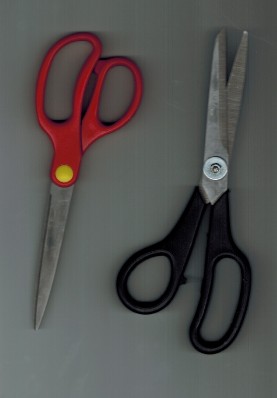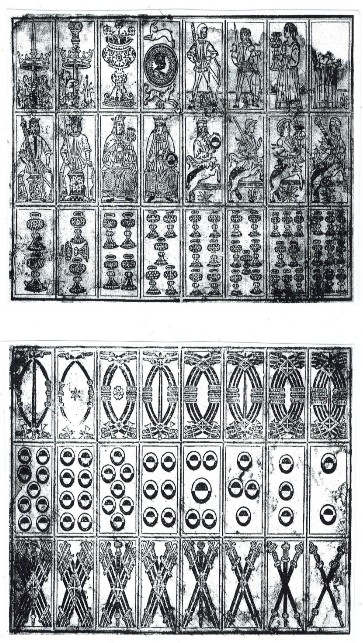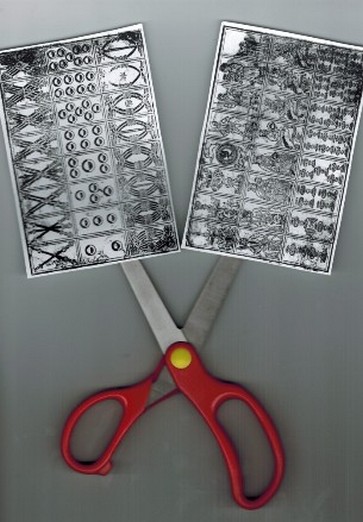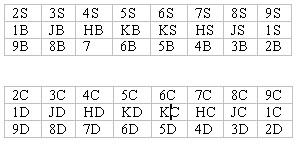
INTRODUCTION
After the insertion of my last notes in trionfi.com, a few friends have commented on them. As for double packs,(1) Lothar Teikemeier indicated in particular that one had to explain why already a single pack was labelled as a pair: «We have from beginning on the problem, that packs of playing cards are addressed as 'pairs'.»(2) He even indicated possible ways of splitting the common pack into two components, such as red and black suits. Now, I am ready to report the results of my reflection on this topic.
1. Pairs of scissors
It seems to me that a pair of scissors is a useful starting point for commenting on a pair of cards, or a "paio di naibi". As a matter of fact, scissors cause no problem of language, because precisely the same concept underlies both the Italian and the English names: "un paio di forbici" exactly has the same meaning as a pair of scissors. In both languages, we encounter the same strange evidence of one object mentioned as if it were… two of them.
If you ask anybody how many items correspond to two pairs, the answer will certainly be four, and not two, as in the Figure. Just by observing the object in question, however, it becomes evident that this particular tool is made by two parts, which have been joined together in its production; ultimately, the tool cannot work any longer as soon as we split these two parts up. In principle, however, the two parts can be disjoined, as one actually does whenever they get sharpened.
For a "pair of cards", the situation looks different, and indeed this idiom does not exist in other languages, nor even in modern Italian. In the early times of the spread of playing cards, however, "un paro di naibi", or "un paio di naibi", a pair of naibi, was instead the typical way to indicate one pack of playing cards. Let us search what naibi could have in common with scissors.
2. Suits and games
Four similar suits can be seen in any pack, and these can be grouped two by two. On the one hand, we find suits that are either round, or red, or feminine; on the other hand, we find suits that are either long, or black, or masculine. This division also had consequences in the rules of some games, in which, for instance, the taking power of the pip cards was either increasing or decreasing according to the "sex" of the given suit.
Our problem is however not solved by these considerations. The only way to explain in a convincing way the use of the pair attribute would be to suggest that our pack of cards could be used disjoined into its two parts, for some games at least: one game you play with cups and coins; another just with batons and swords; alternatively, one group could be formed for instance by cups and swords, the second by coins and batons. A "single" pack could thus consist in 24 cards (or 18, 20, 26, according to place or time). No such game, or pack, has left any trace.
If I must think of some original composition of a card pack that might conform with the requirement indicated above, I have to let my imagination work. I can do it, in considering the game of cards and the game of chess at the same time, as follows.
3. Chess sets and card packs
As often suggested, there could be a strong similarity between chess and cards. Several authors have debated this connection, with much detail, up to the "theory" of Helmut Rosenfeld,(3) who develops this point supporting the view that the original form of chess was precisely the four-handed one, easier to associate with cards.
Chess was however generally played between two players, each of them provided with his own set of pieces, commonly eight more powerful to be placed on the first rank, eight less powerful on the second one.
If we strictly follow a possible analogy between chess sets and card packs, we have to introduce for the simplest card pack two suits of 16 cards, one for either player. However, card games were better played as four-hand games, and to conform with this common use each of the four players has to be provided with "his own" suit, thus obtaining our common pack, in which four different suits are present together. (Exceptionally, packs with five suits, or even more, were produced, and it is immediate to associate them with the corresponding number of players.)
In conclusion, the analogy with chess sets may lead to understand the pair of naibi as it would have corresponded to two sets of chessmen ("a pair" of chessmen), as used in some variants of four-handed chess.
4. Chessmen and cards
The analogy with chessmen can be developed further to include single cards. As a matter of fact, it is easy to connect a given card suit with the "corresponding" chess set. In both cases, we find that about one half of the series is formed by simple "soldiers", such as the chess pawns and the pip cards, accompanied by major military officers or court personages.
Here we find a curious aspect of the analogy. Both chess and cards arrived into Europe from the East, and the only debate about this has been till now in how much Near, or Far, this East had to be considered. However far could the starting point have been, apparently the way of the introduction into Europe was in both cases through the Islamic world.
Originally, it seems that both chess and cards were considered as simulations of armies, with soldiers and officers, headed by a King. In the course of time, the "meaning" of the chessmen in Europe changed from the image of an army to the image of a court. This produced new personages, including female ones (previously absent) to begin with the Queen.
Whereas this transformation is reliably documented for chess, the problem with cards is that we find there Queens already present in the first description that we have of playing cards in Europe.(4) The results of the long transformation that had occurred for chess appear to have been transferred at once to the similar series within playing cards.
If we enter the comparison in more detail, we discover that card suits are not exactly corresponding to eight pip cards and eight cards of military or court personages. Different packs existed with different numbers of these cards. A card suit of precisely eight pip cards and eight courts is unknown to me. Pip cards could be eight, but usually were somewhat more. Court cards usually were only three, augmented to four in tarot and some other early packs; only in a few extraordinary packs more court cards were present, both masculine and feminine.
 |  |
5. Pairs of woodblocks and sheets
I have discussed several points up to now, which can be considered as a multiplication of possible explanations for the pair attribute. Should I limit myself to state the single most convincing (at least for me) explanation, I would avoid to proceed against Occam’s razor, as I did, and use only the following justification.
We know from Rosenwald sheets how a pack of cards could be produced, see the accompanying sheets at the left.(5)
Of course, this was not the only way. This series of 3x8 cards printed on a single sheet with a single woodblock could change into 4x6 with a different shape of the block and the same number of cards, but more reasonably could change into a higher number of smaller cards, or a smaller number of larger cards. Several such blocks and card sheets have been kept, with various dimensions and numbers.
One of the advantages of the 3x8 configuration of the woodblock is that it can directly correspond to card dozens: two dozen in one sheet. In this case, for a 48-card pack, we can obtain two suits per sheet, as hypothetically shown in the following scheme, which is not the same as present in Rosenwald sheets, but is also not too much different. I have used here the initial letters of Jack, Horse, King, and Spade, Bastoni, Coppe, Denari.

The fact that my "pair" is different from the two corresponding Rosenwald sheets may even be considered as a proof that no single "half pair" was produced. You could print all the 48 cards, equally well, by keeping two dozen of them in each sheet as two of the four suits. This was however not necessary, because nobody used just one of the two "half-pairs" that I have outlined here.
As a help for corroborating the suggested explanation, let me come back to the initial pair of scissors and use it associated (of course not in the common way) with a pair of naibi, as in the following Figure. We have thus succeeded in working out the difficult task of finding what naibi could have in common with scissors!
Conclusion
In the early mentions of playing cards in Italy we read that a pack of cards was labelled as "un paio", a pair. This I understand to mean exactly the same as when we use the idiom "un paio di forbici", a pair of scissors.
Whereas the justification of the idiom is easy to understand for scissors, on the basis of the two detachable parts, it remained to find a similar possible division of a pack of cards into two subgroups. I have examined several possible cases, among which the last one appears to be the most plausible: a pack of cards was called a pair because it could not be produced with a single sheet of paper, nor a single woodblock, but required two of them, a pair both of paper sheets and woodblocks, which thus provided "a pair" of playing cards.
Footnotes:
(1) Franco Pratesi: Naibi on Sale
(2) Lothar Teikemeier, Personal Communication, 27 January 2012.
(3) Helmut Rosenfeld, Archiv für Kulturgeschichte, 52 (1970) 65-94.
(4) Trionfi.com: Johannes of Rheinfelden, 1377
(5) Franco Pratesi: Rosenwald's Fourth Sheet
|



